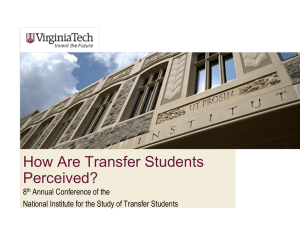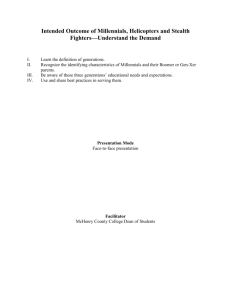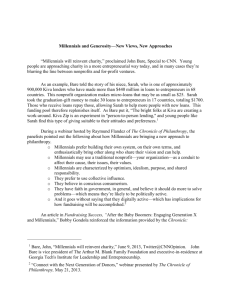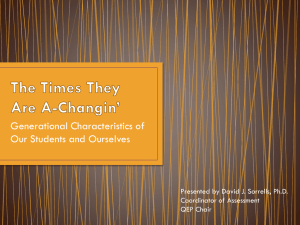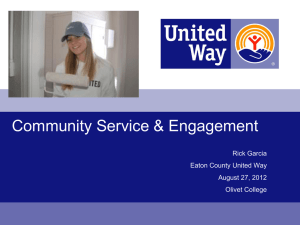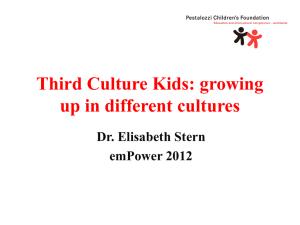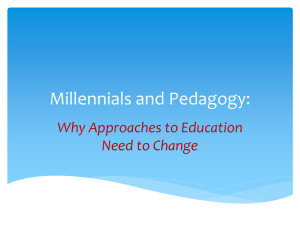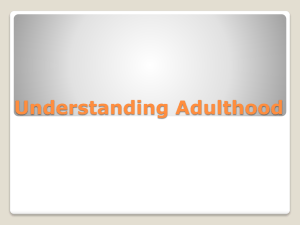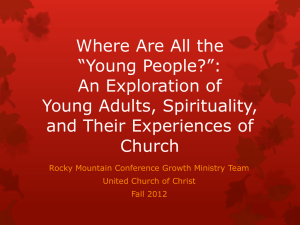48 - Gonzaga University
advertisement
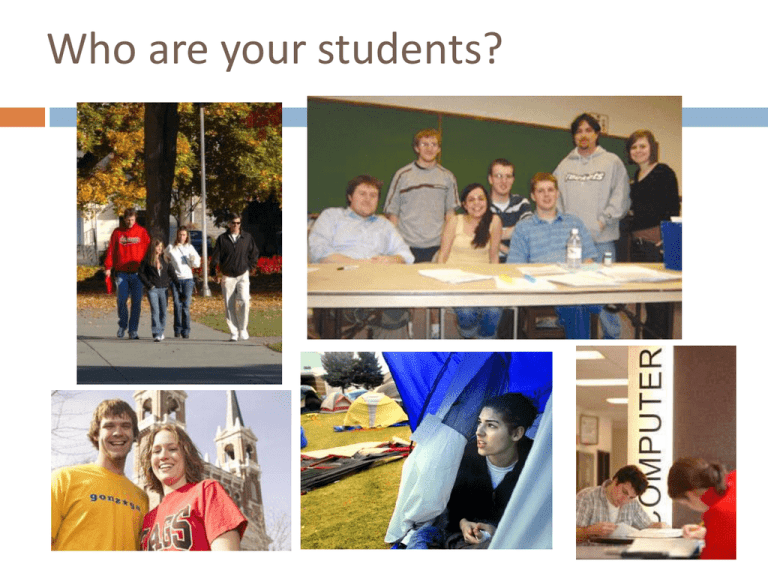
Who are your students? Outline Student development theory Millennial, post-millennial, etc. GU students specifically Student Development theory Nancy Schlossberg’s Theory of Mattering and Marginality (1989) When people begin a new experience they can feel uneasy about their ability and what their role is or should be in that experience. Marginality results in self-consciousness. Selfconsciousness results in the inability to perform up to one’s capabilities. When people believe that they matter, marginality diminishes. Students succeed when they are appreciated by others and receive positive attention. Nancy Schlossberg’s Theory of Mattering and Marginality (1989) Mattering includes: Attention: being noticed Importance: believing one is cared about Ego Extension: belief that someone else will be proud of their successes or sympathize with their failures Dependence: being needed Appreciation: feeling that one’s efforts are appreciated by others Discussion How does this relate to our interactions with our own students? How can we make students feel like they matter in the classroom/lab/office hours? Chickering & Reisser’s Seven Vectors of Development (1993) 1. Achieving competence 2. Managing emotions 3. Moving through autonomy toward interdependence. 4. Developing mature interpersonal relationships. 5. Establishing identity. 6. Developing purpose. 7. Developing integrity. Who are these people and what are their values? Consulting companies Industry devoted to figuring out young people Institutions (education and otherwise) rely on these consultants to understand what it is that a particular generation cares about and ultimately will want to BUY! Discussion How would you describe the students that you have encountered so far at Gonzaga? What are some of their positive and negative traits? Millennials? Born after 1981; come into early adulthood around 2000 Traits Special, confident, sheltered, team-oriented, achieving, pressured, conventional Defined by technology Parented by “helicopter parents” – educated, overly concerned, BOLD! Millennials are aware of the term and don’t like it! Get rid of the terms like “Millennials”! Santilli argues that we should define the period between adolescence and young adulthood as “emerging adulthood” while still acknowledging changes in generations (marrying later, putting off becoming parents). Five essential qualities of emerging adulthood: identity exploration, instability, self-focus, feelings of transition, and openness to possibilities Santilli also acknowledges the match/overlap between the Jesuit education model and emerging adulthood Sweeping generalizations aren’t a good idea Singham is amazed that the same professors and educators who quickly stereotype students in terms of generation are the same professors who display great sensitivity when it comes to gender and ethnic stereotypes Singham argues that what we think we know about students prevents us from actually getting to know them! Okay, so who are our students? Changes from 1990 to 2010 1990 1995 2000 2005 2008 2010 Number of freshman surveyed 260 560 604 784 922 920 Father – BA or higher 51% 67% 72% 74% 71% 74% Mother – BA or higher 49% 58% 63% 68% 70% 75% A+, A, or A- high school avg 49% 64% 70% 67% 64% 72% “very good” chance of B avg at 56% GU 62% 61% 65% 61% 86% B- or lower high school avg 3% 4% 1% 2% 0.4% 11% GU Division of Student Life Research Notes, Spring 2011, Number 5 Reasons for choosing GU 1990 1995 2000 2005 2008 2010 Very good academic reputation 66% 80% 76% 77% 80% 76% Offered financial assistance 57% 64% 59% 62% 65% 71% Graduates get good jobs 50% 55% 60% 59% 61% 62% Religious affiliation 24% 30% 25% 27% 26% 24% Good reputation for social activities 13% 28% 31% 42% 50% 57% GU Division of Student Life Research Notes, Spring 2011, Number 5 When asked to “rate yourself compared to peers”, percentages of GU freshman who considered that they were above average or in the Top 10% 1990 1995 2000 2005 2008 2010 Academic ability 76% 85% 82% 83% 79% 88% Emotional health 54% 65% 55% 60% 61% 66% Leadership ability 55% 68% 67% 69% 66% 74% Self-confidence socially 42% 54% 50% 53% 52% 58% Writing ability 46% 57% 56% 51% 57% 58% GU Division of Student Life Research Notes, Spring 2011, Number 5 Activities during senior year in high school 1990 1995 2000 2005 2008 2010 Performed volunteer work 80% 89% 92% 96% 96% 96% Tutored another student 62% 63% 60% 61% 59% 70% Drank beer 60% 45% 54% 50% 43% 37% Drank wine/liquor 61% 55% 57% 55% 48% 38% No hour per week partying 22% 19% 23% 20% 35% 46% GU Division of Student Life Research Notes, Spring 2011, Number 5 Life goals that are essential or very important 1990 1995 2000 2005 2008 2010 63% 60% 62% 64% 69% 75% 38% 24% 18% 26% 36% 28% 41% 33% 51% 55% 61% 60% Promote racial understanding 48% 38% 30% 39% 39% 37% Raise a family 68% 71% 72% 79% 80% 84% Be very well off financially Become involved in cleaning up environment Develop a meaningful philosophy of life GU Division of Student Life Research Notes, Spring 2011, Number 5 “One of the most important tasks of the academic advisor is mediating the dissonance between student expectations and the realities of the educational experience.” • Wes Habley Percentage of respondents saying that there is a “very good chance” that they will: All Arts Science Bus. Eng. Health Change major 15% 27% 6% 14% 0% 6% Change career choice Work to help pay for college expenses Participate in volunteer or community service 17% 28% 14% 14% 4% 6% 49% 50% 54% 44% 42% 54% 50% 56% 46% 42% 38% 62% Study abroad Be satisfied with college experience 48% 55% 43% 52% 14% 44% 71% 71% 73% 70% 74% 67% GU Division of Student Life Research Notes, Spring 2008, Number 3 Other places where dissonance might occur: • • 68% of incoming male students and 75% of incoming female students had a high school GPA of A- or above. Only 36% studied 11 or more hours per week in High School. (Nationwide, college students report studying an average of only 13 – 14 hours per week, about half what their professors think is necessary to keep up.) GU Division of Student Life Research Notes, Spring 2011, Number 3 Reported grade point averages of seniors, overall and in the major: All Arts Science Bus. Eng. Overall, A- or above 43% 43% 43% 43% 43% Overall, B or B+ 48% 47% 52% 48% 48% Major, A- or above 55% 67% 37% 50% 28% Major, B or B+ 37% 29% 57% 37% 47% GU Division of Student Life Research Notes, Spring 2008, Number 1 Percentage of senior respondents saying that they spent 11 or more hours per week on: All Arts Science Bus. Eng. Studying or doing homework 38% 34% 56% 27% 69% Socializing with friends 48% 47% 36% 57% 49% Exercising or sports 14% 12% 9% 20% 16% Partying 15% 12% 9% 24% 20% GU Division of Student Life Research Notes, Spring 2008, Number 1 Expectations versus reality Eight percent of college seniors are “proficient” at level 3 math, up from 5 percent of freshmen. Eleven percent of college seniors are “proficient” at level 3 writing. Six percent of college seniors are “proficient” in critical thinking, 77 percent are “not proficient”. Less than 13 percent of college students achieve basic competence in a language other than English Less than 34 percent of college students earn credit for an international studies class; of those who do, only 13 percent take more than four classes. Less than 10 percent of college students participate in study abroad programs. Academic Profile, Educational Testing Service (2003–04); Clifford Adelman, “‘Global Preparedness’ of Pre-9/11 College Graduates: What the U.S. Longitudinal Studies Say,” Tertiary Education and Management 10 (2004): 243. Who are your students? References for Student Development Theories Schlossberg, Nancy K. “Mattering and Marginality: Key Issues in Building Community” New Directions for Student Services, 1989, 48, pp. 5-15. Chickering, Arthur & Reisser, Linda (1993). Education and Identity. San Francisco: Jossey-Bass Publishers. Skipper, Tracy L. (2005). ”Chapter 2: Psychosocial Theories of Student Development” in Student Development in the First College Year: A Primer for College Educators Columbia, SC: University of South Carolina, National Resource Center for The FirstYear Experience and Students in Transition. References for Millennials Howe, N. and Strauss, W. (2000) Millennials Rising: The Next Great Generation, New York: Random House, Inc. Santilli, Nicholas (2010) “Don’t Call Us Millennials!” in Conversations on Jesuit Higher Education: Vol 37, Article 6. Singham, Mano “More Than ‘Millennials’: Colleges Must Look Beyond Generational Stereotypes” The Chronicle of Higher Education, Oct. 2009. Hoover, Eric “The Millennial Muddle” The Chronicle of Higher Education, Oct. 2009.
